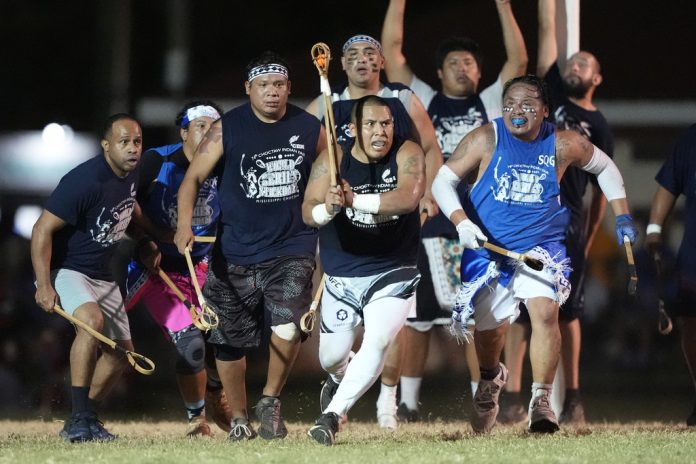CHOCTAW, Miss. (AP) — As the drummers walk onto the field, the players behind them smack their hickory sticks to the beat. The rhythm envelops the stands and a palpable sense of anticipation flows through the crowd.
Indigenous peoples have been playing stickball for hundreds of years, and every summer since 1975, teams have competed in Mississippi to become champion of perhaps the oldest game in North America.
A game of physicality and endurance, stickball is often referred to as the grandfather of field sports and the annual tournament in Mississippi is the game’s premier event. The Mississippi Band of Choctaw Indians has been producing some of the country’s best players for generations. A team from Mississippi will almost certainly be the one to beat in any tournament or exhibition game in the country.
No pads, no timeouts, no mercy
As the July sun set on another sweltering day, hundreds of people gathered at the Choctaw Central High School football field and sat down on the Indian blankets they had draped across the metal seating. Others lined their folding chairs along the chain-link fence to get a glimpse of the action.
Stickball, known as ishtaboli in the Choctaw language, is played with 30 players on the field, each carrying two netted sticks called kabotcha, and a small woven leather ball painted bright orange, called a towa.
Stickball fans say it remains pure. There are no pads, no timeouts and no mercy. Players typically don’t even wear shoes. It is not uncommon for people to leave the stickball field with broken bones from full contact, or gashes from taking a stick to the face. Any player possessing the ball can expect to be tackled or torn down by their jersey or breechcloth.
“It makes your heart just beat like a drum. Just the intensity of the sport,” Mississippi Band of Choctaw Indians Chief Cyrus Ben said. “At the end of the day, it doesn’t matter what color jersey or what team, it’s being Choctaw.”
Although the game is high-contact, it is so respected by the Choctaw, and so central to their cultural identity, that no hit is taken personally, no matter how intense. Players often slam each other so hard that their sticks go flying through the air, and they simply get back up, nod to each other, and race down the field after the ball.
Variations on stickball have traditionally been played by several tribal nations using rules created by the Mississippi Band of Choctaw Indians.
Players are not allowed to hit each other with their sticks, although that happens routinely when players huddle around a loose ball. Late and early tackles are prohibited, and anything above the shoulders is off-limits.
The field is never empty
Chief Ben, like many here, was given a pair of sticks as soon as he could walk. Some recall sleeping with them above their pillows and a ball underneath. Boys and girls play together in the youth tournaments the night before the men’s and women’s championship games every year at the Choctaw Indian Fair. All over town you will see kids with sticks poking out of their backpacks.
The field is never empty. Children play stickball before every game — living out their fantasy of one day claiming victory on the same field. Between that, the snow-cone stand, and the almost fanatical way the assistant coaches scream from the sidelines, it’s as familiar as any Friday night high-school football game.
This year, Koni Hata, the 2023 men’s champion and one of the most dominant teams in the modern era of stickball, defended its dynasty in both the men’s and women’s title games against neighboring Choctaw communities such as Pearl River and stickball powerhouse Bok Cito.
The finals started with the women’s championship, Bok Cito Ohoyo taking on Koni Hata Ohoyo, which was looking for its second threepeat in the last seven years. Scoreless at the end of regulation play, the game was decided in sudden death when Bok Cito Ohoyo center shooter Leia Phillips scored with a running midfield shot.
“I said, ‘yeah, it’s my time to shine, this is my shot right here, you worked all year for this,’” Phillips, the women’s tournament MVP, said after the game.
Blood, gashes and breaks
The men’s game between Koni Hata and Pearl River was highly physical, and several skirmishes for the ball ended with sticks shooting through the air “like my 9-iron,” one announcer said. Several players were treated by medics for a variety of injuries including a bleeding eye and a gash across the forehead. Earlier in the tournament a player suffered from a broken nose.
Pearl River had no trouble scoring during tournament play, racking up an impressive 41 points in its first three games. They scored in the first half, but the point was negated for having 31 players on the field. Koni Hata scored in the second half but that point was also taken away for having too many players on the field. But Pearl River scored late in the fourth quarter and took home the ceremonial drum presented by Chief Ben.
As the Choctaw Indian Fair was winding down, Jackie Morris, the coach of the team from the community of Bok Cito, waited in line for a hot dog. He made sure that every passing Bok Cito player had a chance to sign the drum slung over his shoulder.
“This is what we play for,” he said, patting the trophy. On the field nearby, drums and sticks beat together.
Source: post





